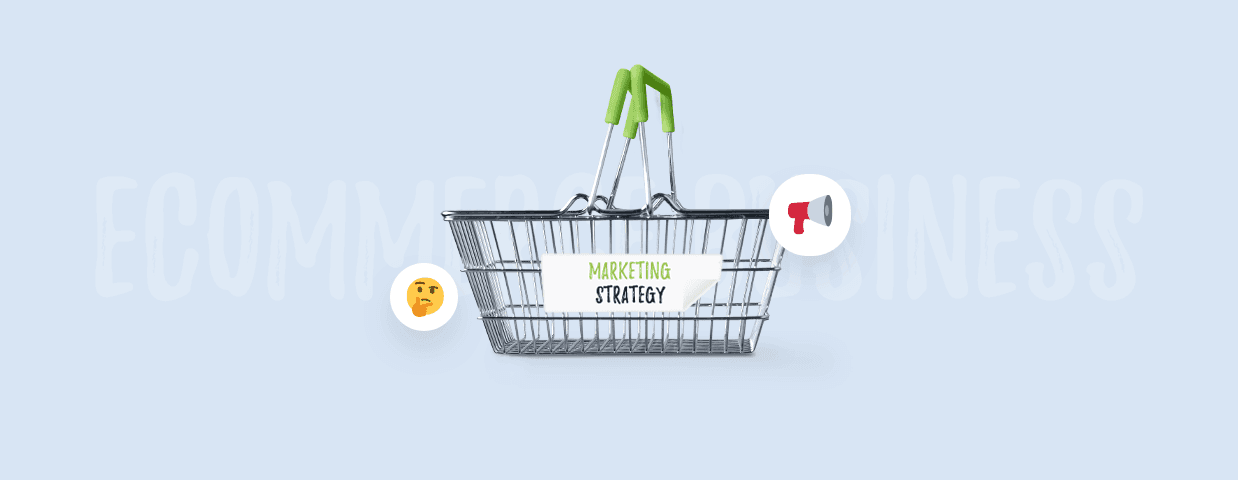You finally made it, you built your very own Shopify store from scratch.
“And now what?” you might be wondering.
Now, it’s time you learn how to make money with it.
Boost your Shopify website with a live chat to connect with your visitors faster
No one said it would be easy but it’s imperative that you start selling with your Shopify store if you want to have a steady flow of monthly income.
Truth is, mastering sales is not an easy task. In fact, hitting sales and revenue targets is one of the biggest challenges that small businesses face. But lucky for you, we’ve got you covered.
In this article, we will show you how to go from making $0 to running a successful Shopify business. We will help you choose the right tools and strategies that suit your needs (and your budget!) best, and show you how other companies succeeded along the way.
Here’s what we’ll cover:
- Why do I need a marketing strategy?
- How do I pick the right strategy for my business?
- Marketing strategies every Shopify entrepreneur should know
Are you ready to dive in? Let’s do it!
Why Do I Need a Shopify Marketing Strategy for My Business?
Think about it this way:
Without a map, you can get lost. It’s impossible to know whether you’ve reached your destination (hit your sales goals) and whether the sales techniques you use are effective.
A good marketing strategy will help you with estimating the reach of your business and your sales potential. You’ll have measurable goals to keep your eye on. As the famous saying goes: what can’t be measured, can’t be managed.
And what isn’t planned, cannot be successfully executed.
You need a solid marketing strategy for your Shopify business if the idea of making money is why you’ve opened the store in the first place.

By definition, a marketing strategy is a business plan that helps to promote a company’s goods or services to attract new customers and maintain strong relationships with the existing ones.
(If that sounds boring, just think about it as a plan for making you rich).
Let’s face it: setting up a Shopify store takes 2 minutes. Everyone can do it, literally.
What does it mean for you?
With more than 800.000 stores powered by Shopify in 2020 alone, you can expect your competition to be plenty and quite fierce, to say the least.
What is the good news?
Having a killer marketing plan for your eCommerce business on Shopify puts you ahead of all those who count for the best without a strategy in place.
So, let’s make you a Shopify sales pro, starting with answering a question…
How Do I Pick the Right Strategy for My Ecommerce Business to Double My Sales in 2021?
Don’t bite off more than you can chew. Before you decide which marketing strategy suits your Shopify store best, ask yourself the following questions:
- What is the main objective?
- How does a given strategy help me achieve my goal?
- Who represents my target audience?
- How much money can I spend every month on my strategy?
- How many extra hands will I need to execute the strategy?
- Am I a small/medium/big company?
Depending on your answers, the “right strategy” will depend on the following aspects:
- budget
- target audience
- product/service
- and workforce
For instance, if your budget is small, you’d probably employ search engine adverts with low CPC rather than YouTube commercials that can be costly to produce.
Similarly, if your product is designed for GLAMs (Greying Leisured Affluent Married), using Snapchat or TikTok as your main sales channel wouldn’t make much sense.
If you run a one-person business, you should consider automating some of the tasks to ease the work overload.
On a large scale, the right marketing strategy depends on the size of your company. Here is a little booster from companies that already succeeded on the platform.
Great Examples of Businesses Which Chose the Right Strategy
Mama&Little is just one of the examples of small businesses that managed to successfully grow on Shopify by adopting Instagram as their main sales channel.
When the store’s owner decided to launch an online store, she had barely a product vision and $1500 in cash. Within the first year upon kicking off with the strategy, her sales doubled every month and she continued to grow at a fast pace.
Today, you can find her products in over 30 stores including big names like Nordstrom.
Sephora is an example of a big company that can also flourish on popular platforms like Shopify. The store is undoubtedly a pioneer in the cosmetic industry that has made use of chatbots to help customers find items from the comfort of their homes.
The company has also decided to use Messenger live chat to answer customers’ queries on Facebook. Here’s what it looks like:
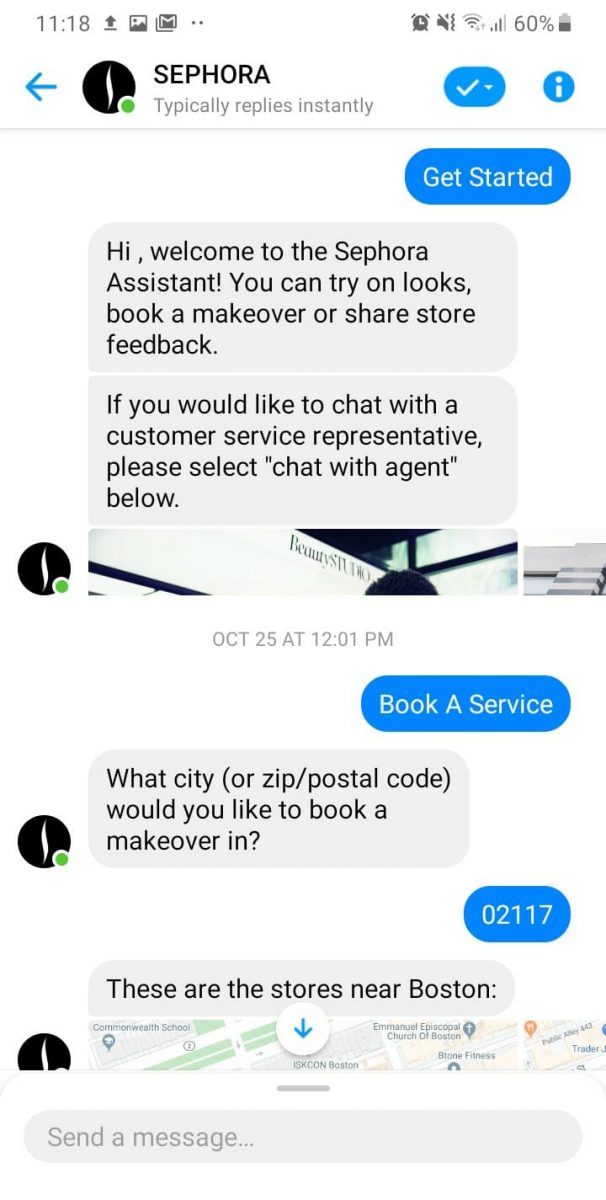
(PS: You can do the same for your business by integrating Tidio with Facebook Messenger in less than 1 minute).
But, offering relevant product offers isn’t everything that the best Shopify bot can do.
From then, they can lead customers to the “add to cart” and “buy now” stage and tempt them with special discounts to ensure successful transaction completion.
As a result, chatbots allowed the company to close multiple transactions which consequently generated online net sales of $920 million in 2018.
That’s hella lot of money!
Conclusion?
Chatbots can help you close tons of sales and save time.
If you put trust in Tidio, you’ll see the results immediately. Just like one of our customers did:
What can I say, installed the app, set it up and within the first 24 hours we had almost £2000 in sales. Worth every penny.
Colin Barker
securitybollardsdirect.co.uk
8 Killer Strategies to Make a Fortune on Shopify This Year
- Deploy Chatbots for excellent customer experience
- Send email sequences to engage all customer segments
- Address doubts with video tutorials of the products you sell
- Endorse on-site personalized product recommendations
- Shorten the checkout process
- Start an affiliate program
- Add shoppable posts on Instagram
Let’s consider them one by one.
1. Deploy Chatbots for Better Customer Experience and Sales Automation
Excellent customer service delivery will undoubtedly help you stand out from the competition and help customers decide whether or not they should spend money with you.
WalkerInfo predicted that customer experience will beat price and product as the most important brand differentiator this year.
[bctt cta_name=”how to sell on shopify – real money” tweet=”To start making real money with your Shopify store, you need to make sure that every single customer that comes to visit your website is treated like a king or a queen. ” nofollow=”yes”]
With chatbots, you’re giving them VIP treatment necessary for them to decide to close the deal with your store.
One of the key factors contributing to delivering exceptional service is the response time. A study has shown that speed of response (89%) and speed of resolution (89%) are seen as the most important aspects of customer service experience, regardless of the channel.
Lucky for you, chatbots can do both.
How will chatbots deliver excellent customer experience and boost your sales?
Since 2016, chatbots have risen in popularity and been deployed by a number of companies operating in different business sectors – banking, health, eCommerce, media, restaurant, fashion industry, insurance.
There are two reasons why – they can provide quick answers to customer queries and resolve complaints (see the table below).
By deploying a FAQ chatbot to a website (a special type of chatbots responding to routine questions, like e.g. shipping prices), your customers won’t have to queue in a telephone line for an hour to receive crucial information.
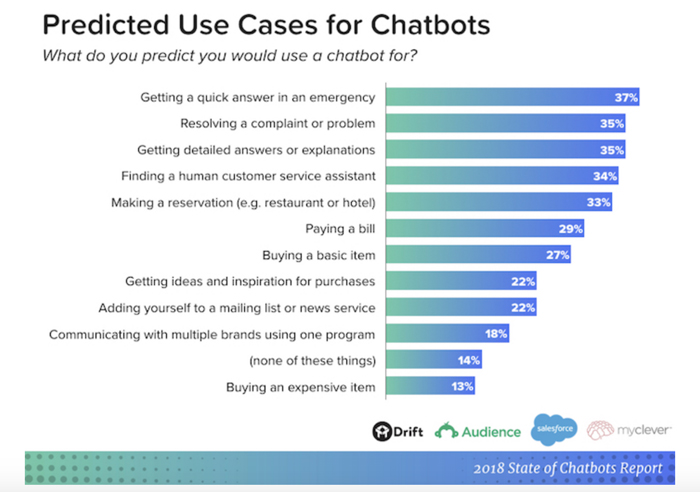
Customers want their problems to be addressed quickly and resolved on the spot. But if you’re a single-handler running the business on your own, responding to all inquiries at once is merely impossible. And we get it, you’re short on time.
This is why chatbots have been created.
Chatbots (computer programs designed to simulate human conversation in natural language) can resolve all customer’s doubts regardless of the daytime or time zone. They work 24-7-365.
They don’t complain or take days off, isn’t it a definition of a perfect employee?
Tip: Find out more about chatbots and chatbot design in the Chatbots section of our blog. When you feel ready, try creating your own chatbot with Tidio Chatbot Editor.
The moment you deploy chatbots on your site, they will address all inquiries at once as they can handle multiple customer responses simultaneously and respond to them immediately.
For example, the average response time of Tidio chatbots is just three seconds.
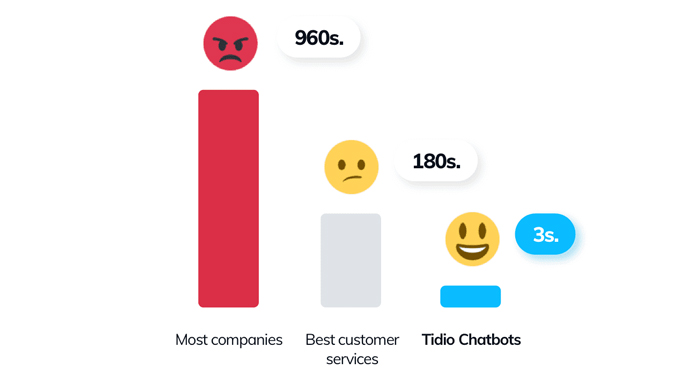
However, chatbots aren’t only the tool solely dedicated to customer service.
Here are some additional things Tidio’s chatbot can help you with:
- Manage product orders
- Make product suggestions
- Track, tag, and segment your audience
- Collect email addresses (lead generation)
- Automate your sales process
- Help you create your own brand voice
- Help you reduce the Shopify cart abandonment rate
[bctt cta_name=”how to sell on shopify – roadmap” tweet=”Chatbots can help to market your products by tailoring offers based on customers’ preferences, past purchase behavior or on-site activity, and target them with offers immediately after customers revisit your store. ” nofollow=”yes”]
Chatbots can help to market your products by tailoring personalized offers based on customers’ preferences, past purchase behavior, or on-site online activity, and target them with offers immediately or next time customers revisit your store.
By helping you tag and segment your customers you are able to target them with personalized email campaigns with just a few clicks.
Vichy bot is just one of the chatbot examples that has been deployed to render customized services on the brand’s website store.
What does this chatbot do exactly?
It helps to choose the right skincare products from Vichy’s cosmetics range based on interviewee’s answers about their skin and overall preferences.
See the Vichy bot in action.
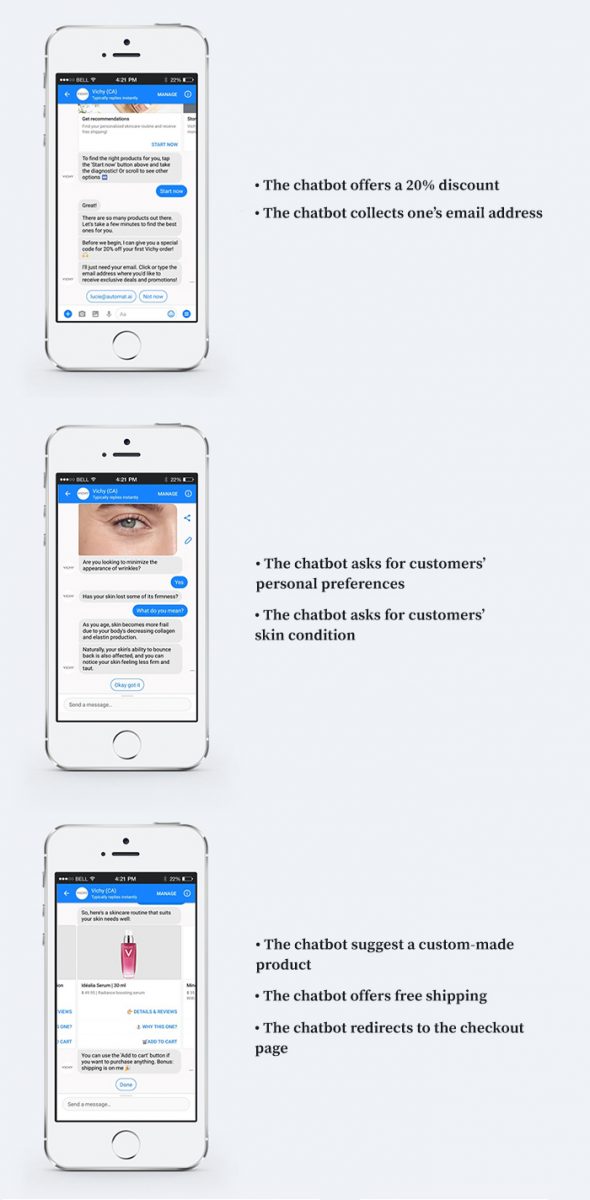
As you can see, the Vichy bot didn’t just suggest a product, but also offered a discount, collected one’s email address, offered free shipping, and redirected to the checkout page if one clicked the “add to cart” button (5).
Tidio, for instance, offers 16+ ready-for-use chatbot templates that have helped 300 000+ of our clients enhance communication with their customers, generate leads, and increase Shopify sales:
The perfect solution for collecting leads, giving discounts, helping customers, and anything else you need for engagement on an e-commerce site. It’s so easy to use and brilliantly designed. Don’t run an e-commerce site without it!
Eris Sharon
studioljewelry.com
With 22 chatbot templates, you can start engaging new customers by sending them a welcome message, prevent potential customers from leaving the site empty-handed, stop them with an abandonment cart message and gather leads’ contact details to send them follow-up emails.
Going further, chatbots can track visitors’ behavior on your Shopify store website and provide you with the following information: what page a customer is currently browsing, how many times they’ve returned to a particular page, and whether their shopping journey ended with a product purchase.
With this data, you can segment website visitors (by tagging them with freely chosen criteria) and then fire a bot to offer them personalized service. For instance, if someone visited a certain product page for the third time, a chatbot could offer them a tempting discount code.
Here’s how segmenting your audience based on the URLs they came from looks like:
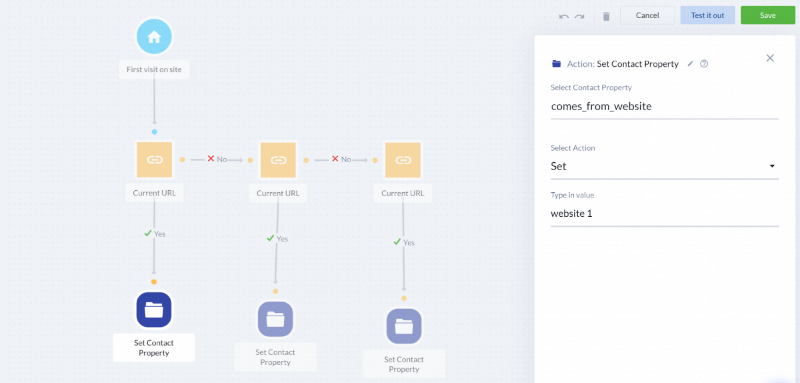
While conversing with visitors, bots can also ask for contact details (or any other information of your choice, e.g. a favorite music band) with which you could follow them up by sending personalized email campaigns.
2. Send Email Sequences to Engage All Customer Segments
Sending automated sequences of messages by email is a part of email marketing – a marketing approach used to promote company goods to newcomers and to develop relations with existing customers via emails
An email sequence is a series of automated email messages sent to customer segments after a designated period of time.
Contrary to popular belief, sending emails is still much in fashion. Last year alone, the number of global users actively communicating via this communication channel was as high as 3.9 billion and the number is believed to hit 4.3 bn in 2023.
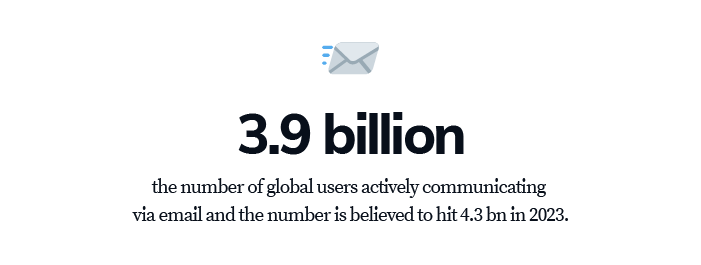
Every day people open a great number of promo emails because they like the thrill of getting a fresh portion of custom product suggestions.
Bikerhelmets.com managed to reach 40% of ROI with email marketing in just three months by sending personalized action-based email messages (emails triggered by a specific activity, e.g. the first visit to a website, product repurchase, cart abandonment, etc.)
Different types of activity are considered the basis for customer segmentation.
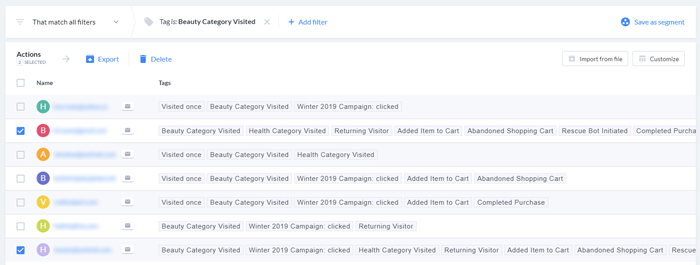
How to segment customers?
To mount a crazy-successful email campaign, every business owner (regardless of their company’s size) should categorize customers according to their purchase behavior (actions/lack of actions). After having categorized the stage of the customer lifecycle, you’ll be able to prepare email offers corresponding to their needs.
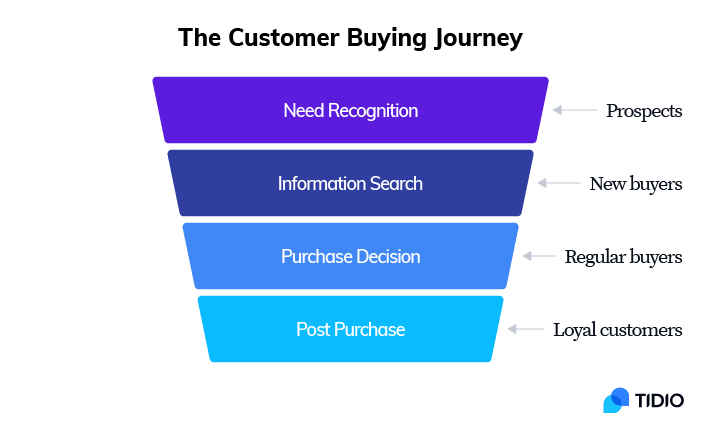
Based on the customer buying journey, we differentiate four types of customers:
- Prospects
- New buyers
- Regular buyers
- Loyal customers
Prospects are considered those who have left their personal details via a contact form to stay in touch with a company they got interested in. Often, they provide their data after having browsed the page and when they’re on the verge of leaving the store’s website.
This means a quick welcome email should be sent immediately after the sign-up process as the brand’s name and products are still fresh in customers’ minds. The purpose of the message is to greet the visitor to the corporate family and introduce them to the company’s main focus and mission.
| Hello, [customer’s name]! Welcome aboard! We’re very happy to have you on our team. Quickly about [company name]. We’re a company that specializes in [xxx] and our mission is to provide clients with [xxx]. Every day, we work hard to deliver fast solutions and best quality products to our community members and make their lives easier. We’d love to stay in touch with you, so go ahead and follow our blog [link] and social media [link]. Have a wonderful day! [Company name] |
Tip: By sending a pre-chat survey, chatbots can ask customers for their name and email address even before the conversation begins. With this information, you’ll be able to better personalize marketing campaigns in the future.
Then, there are first-time buyers. As the name suggests, first-time buyers are those who have selectively chosen a company in order to test their products.
The quality of the item, as well as the overall experience with the brand (checkout, shipping, and delivery process), will be a decisive factor in whether they’ll be tempted to use the same services in the future.
After a customer purchased a product from your Shopify store, send an informative email about the basic order information and a link to your website. Also, don’t forget to say thank you for choosing your store over the competition.
| Hello, [customer’s name]! Thanks for shopping with [company name]. We’re happy to announce that your order is now being processed and very soon will be delivered to your doorstep. To check out the order status, log in to the website [link] or click the button below. Track your order |
Regular customers will frequently and willingly come back to you. However, you two are not exclusive. When they feel like buying a new pair of jeans, they will do a little investigation on brands that offer the best deals.
If you want to be the first choice of your customers, send a special offer email and be one step ahead of the competition. Tempt them with discounts, gifts, freebies, giveaways, you name it.
| Hello, [customer’s name]! We just wanted to say thank you for your contribution to [company name]. In return, we want to offer you a little something as a thank you gift – a $20 gift card. Looking forward to further cooperation, [Company name] |
The last group that requires the biggest token of appreciation are the loyal customers who come back to their favorite store on a regular basis.
A study has shown that loyal customers spend up to 18% more money with the brand if they participate in a loyalty program. Show your gratitude, tell them how much value they bring to the table and invite them to take part in the loyalty program.
| Hello [customer name]! It has been a year since your first purchase with [company name]. Let’s celebrate with a special treat just for you -> 30% off + free shipping for your next order. Also, we want to invite you to partake in our loyalty program. Some of the perks and benefits that come together with it include: [xxx]. And that’s all because we love you so so much. Thanks for being our loyal fan, [Company name] |
[bctt cta_name=”how to sell on shopify – roadmap” tweet=”With Tidio, you can segment all customer types based on a chosen category. Next to collecting one’s contact details (like a phone number or an email), you can also ask for their shoe size, date of birth or favorite color. ” nofollow=”yes”]
The choice is yours.
With chatbots, you can create an unlimited number of custom properties (shoe size, email address, favorite color) and target customers with personalized messages.
3. Address Doubts with Video Tutorials of the Products You Sell
The growing popularity of social media has stimulated daily video consumption. On average, people watch 16 hours of videos a week. That’s more than three hours a day!
Can’t believe it? Check out our cool infographic about video marketing.
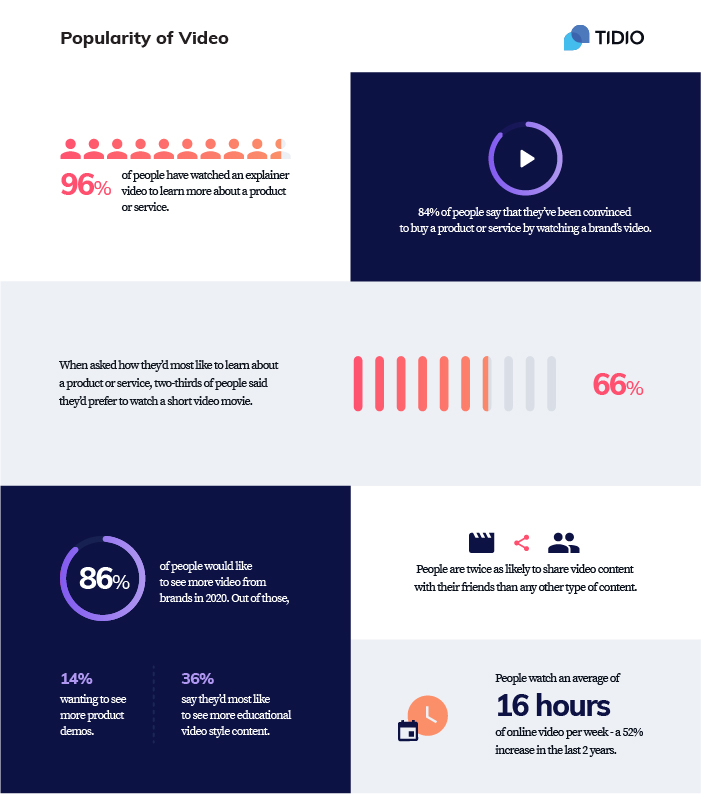
The video trend is insane. People are keener on learning about a product from a video rather than scrolling through tons of photos. That’s why it’s important to create high-quality videos that are both informative and engaging. That’s a chance for you to showcase the goods you sell on Shopify to the rest of the world.
But why? Why do people love watching these a few seconds long videos? Is it because they’re …?
Short?
Yes, because the human attention span is only 8 seconds long.
To-the-point?
Yes, because we like acquiring new knowledge.
Funny?
Yes, because people like being entertained.
For customers, videos are a new source of knowledge or entertainment (depending on which type of video you’re filming – explainers, interviews, product demos, etc.). For company owners, they’re a great tool to appeal to a wide audience, foster trust, and develop a strong relationship.
How to produce an appealing and profitable video in 4 steps?
Before you sit down and make the video, there are three main areas you need to pay special attention to. And these include: understanding video SEO, choosing the right distribution platform, constructing a video transcript, and creating a clickable thumbnail.
Step 1
First off, SEO is necessary for your videos to rank high in Google’s search engine for a certain keyword.
For example, if a customer is typing “the best kitchen appliance” in the search engine, you want your Shopify store to be the first search result. And if your SEO is on point, you will bring tons of traffic to your Shopify store with your videos. Pretty cool, huh?
Step 2
Second off, choose the right distribution platform. Facebook (88%), YouTube (76%), and Instagram (65%) are the three leading online platforms you want to invest in – they’re free of charge (the setup and management) and you don’t have to put a lot of effort into uploading videos and tracking their performance.
Step 3
Thirdly, write down the video transcript. Before you take out the camera to start recording, make sure you know what you want to say frame-by-frame. Outline the main ideas put them into words and transcribe them on paper.
Don’t know how to get on with it? Here is a template and get down to it.
| 1-3 min | Introduce a problem common to your target audience | Does [problem] sound familiar to you? Are you tired of …? |
| 1-2 min | Tell them there is a better way to handle the problem | [product’s name] has been designed for businesses like yours The aim of our products is to help you with… |
| 1-2 min | Show off your product | Meet [products’ name][product’s name] is our newest addition |
| 1-3 min | Praise the product for its design, management and functionality | With [product’s name] you will never want to use anything else We guarantee that this product will help you to… Buy [products’s name] and enjoy the benefits after the first use There is no one thing that you and your family couldn’t do with [product’s name] |
| 1-2 min | Call for audience’s immediate actions | Get a move before others get before you Treat yourself with [product’s name], you deserve it |
Step 4
Later, design a clickable thumbnail and include the video’s title and description. Also, don’t forget to put a video transcript. Phil Nottingham, a video marketing strategist at Wistia, encourages adding the copy as it provides more indexable text that can rank for more queries.
Example of a well-executed video
Lastly, remember to “wow” the viewer. Tom Dickson’s renowned video campaign Will It Blend succeeded because of the unconventional idea.
What did the founder of Blendtec do? To showcase the durability of his blender, he put electronic devices to the test ranging from an iPhone X to Ford Fiesta.
Here’s the video.
The video has turned out to be a huge success – it has been on everyone’s lips for several months. People talked about the campaign, shared it with others and made it go viral. Consequently, Dickson made a lot of money:
“When the Will It Blend videos hit, our sales went up 1000% in week one. I guess that was the tipping point.”
Want to become equally successful? Then, experiment, experiment, experiment – hoover the sandpit with a vacuum cleaner, slide down the sandpaper with a razor, wash the red dress three times in a row.
In a word, replicate the idea to fit into the frameworks of the products you sell in your Shopify store.
4. Endorse On-site Personalized Product Recommendations
Did you know that 56% of online shoppers are more likely to return to a site that offers product recommendations and 49% purchased a recommended item even though it was not their initial intention?
Why the sudden change of heart?
Because people associate an excellent shopping experience with a personalized approach.
ThreeDropsOfLife.com, a store selling health products, is living proof of how much customization actually matters. The company managed to increase its sales by 75% by showcasing personalized product offers to the most loyal customers in an online campaign.
As a result, product recommendations increase up-, cross-and proactive selling opportunities for your Shopify store.
Upselling
Let’s say someone is looking for a new pair of sneakers. To find the perfect match, they need to go through hundreds of other offers before they decide on one. So, they click on the first pair of shoes, the second, third, fourth, and so on.
Based on all of the viewed product pages, a recommendation engine is capable of suggesting other relevant shoe models, but at a much higher price.
Just by adding a “You may also like” or “Buy the look” section (by default), you can push more expensive product alternatives to customers who may find them more appealing than the previous ones. This is called up-selling.
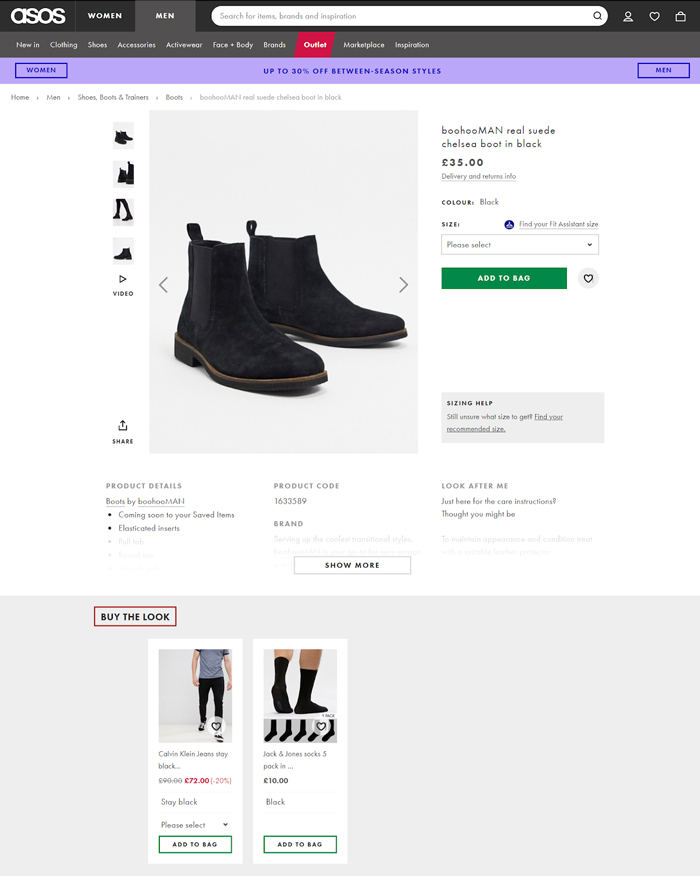
Cross-selling
Another marketing term that you should know to be able to sell on Shopify is cross-selling. This means that you can recommend complementary goods to the ones that someone has already purchased.
A dress won’t be sufficient if it’s not accessorized with a belt, earrings, and a clutch. Don’t you agree?
Entice customers with smaller items towards the end of their buying journey (most preferably at checkout) as it encourages last-minute and impulsive shopping – 25% who click on these recommendations end up buying them.
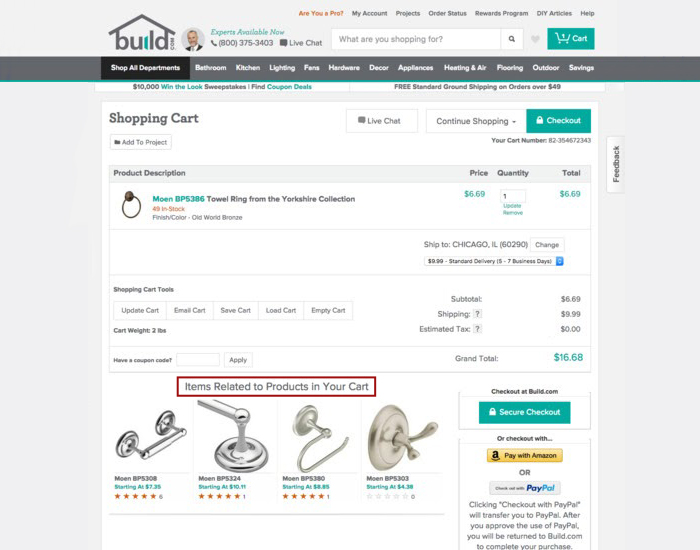
However, as an enterprising business owner, you can supplement the strategy by additionally deploying chatbots to a website. Similarly to the product recommendation engine, they’re also capable of providing relevant searches based on customers’ preferences.
Proactive selling
Lastly, we have proactive selling.
Proactive selling aims at addressing customers’ needs even before they realize what their wants were. Rather than waiting for a visitor to make a move (like leaving the website because of insufficient info onsite), try to outpace them by sending a chatbot message.
Here’s an example of how this works in practice when you use Tidio.
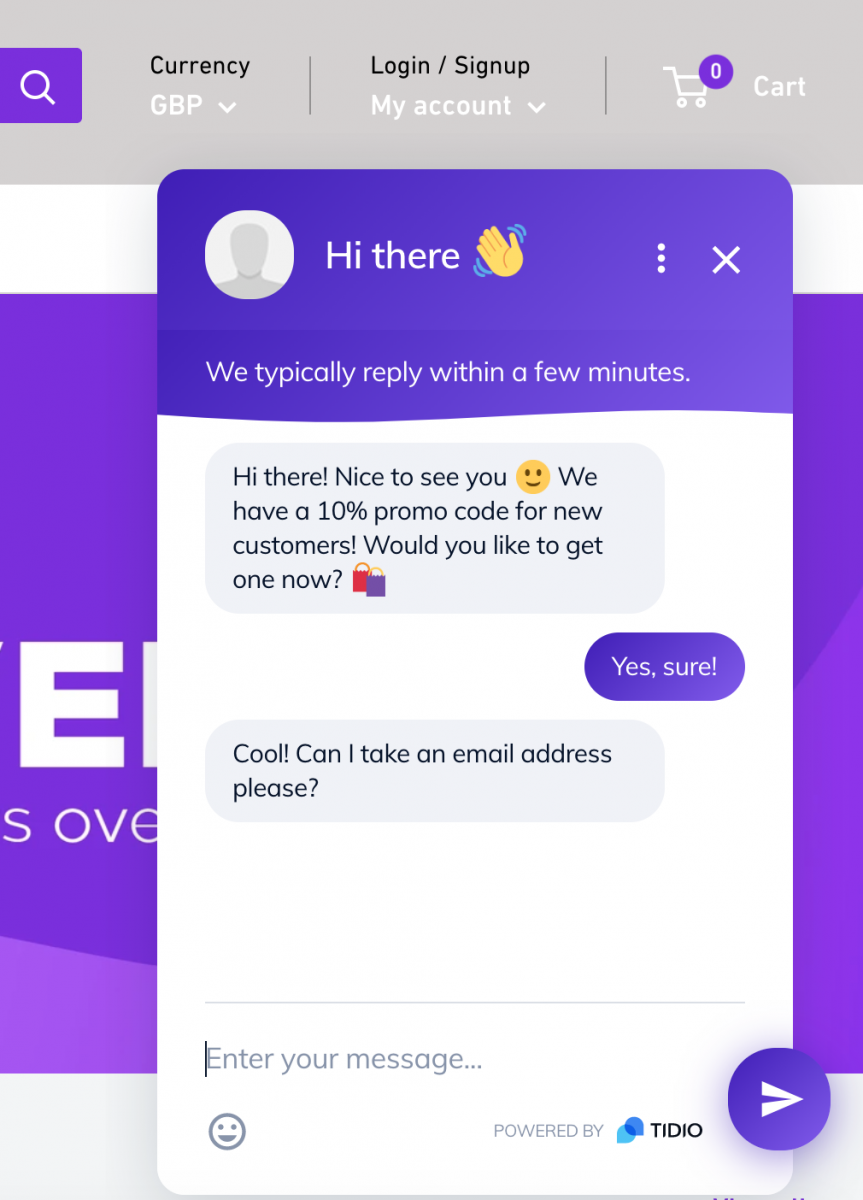
Plus thanks to Tidio’s Visitors feature, you’re able to see exactly what pages customers are currently browsing and assist them during the visit.
For instance – if you see that a shopper started filling in the contact details in the checkout stage but eventually evacuated, why don’t you ask him for the reason for his leaving?
Yes!
You can do it via chatbot message and then when you already know about the problem, you could either send a follow-up email or send another chatbot message the moment the visitor reenters the same page!
Or, you see that a customer is staying on a product page for a longer time now, why don’t you ask if they need any assistance in finalizing the deal or give them a little booster so that they’re more prone to purchase the item?
It’s all possible with having chatbots on your site!
If you prefer to reach out to your store visitors personally in real-time, you can add a Shopify chat app to your store.
5. Shorten the Checkout Process
You can very easily kill your business growth. A poorly designed checkout can hamper user experience if it takes too much time to go through all of the confirmation tabs.
As a result, more and more customers abandon their carts and leave the store empty-handed.
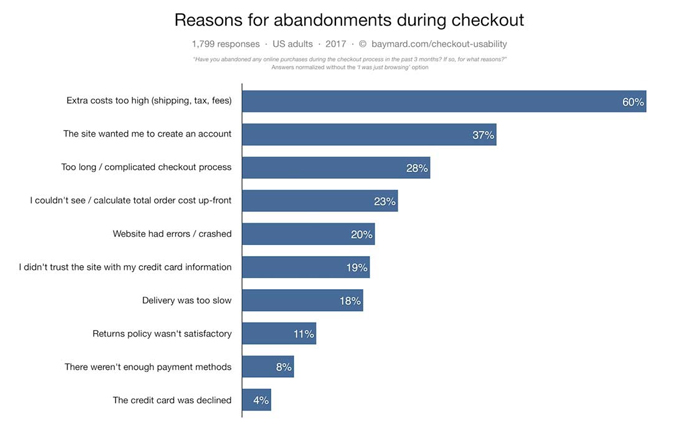
The average abandoned cart rate is as high as 77.73%, which means approximately $4.6 trillion worth of merchandise is abandoned every year.
Luckily, some of it (~ $260 bn) can be recovered with an improved checkout workflow.
How can I optimize my checkout process?
With Google Pay.
Google Pay is a payment app designed to reduce checkout abandonment as it involves fewer steps than a traditional multi-step checkout.
Now, all Android users whose credit card information has been stored on Chrome can checkout with the app by single-tapping the “G-Pay” button.
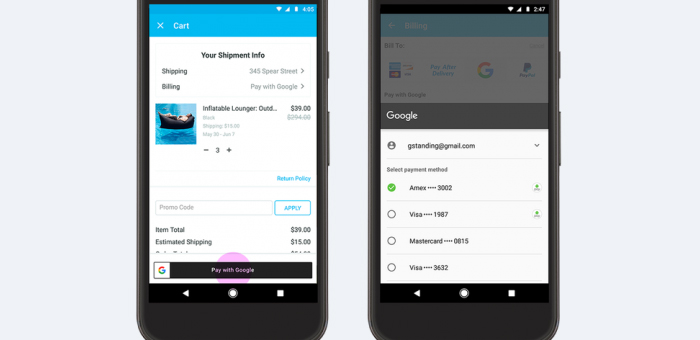
As you can see, it’s all very easy and takes a few seconds to complete. All you’ve got to do is select a payment form (1), press the button (2), enter a shipping address (3) and confirm the order (4).
Easy and effective.
Boxed, an online wholesaler has grown to over $100M when they started using Google Pay as the checkout tool. Consequently, they saw a significant increase in the conversion rate after the checkout time had been decreased.
John Kim, the technical lead at Boxed admits that “digital wallets will be a large part of future transactional growth and Google Pay is a beneficial tool that helps to achieve it.”
6. Segment With Google Analytics and Retarget With Facebook Ads
To run a successful advertising campaign, you need to remember that the needs of all of your clients differ. This is why we’ve categorized them into four distinct groups (see customer segmentation in the email marketing section) on the basis of where they stand at with their purchase decision.
Look at the graph.
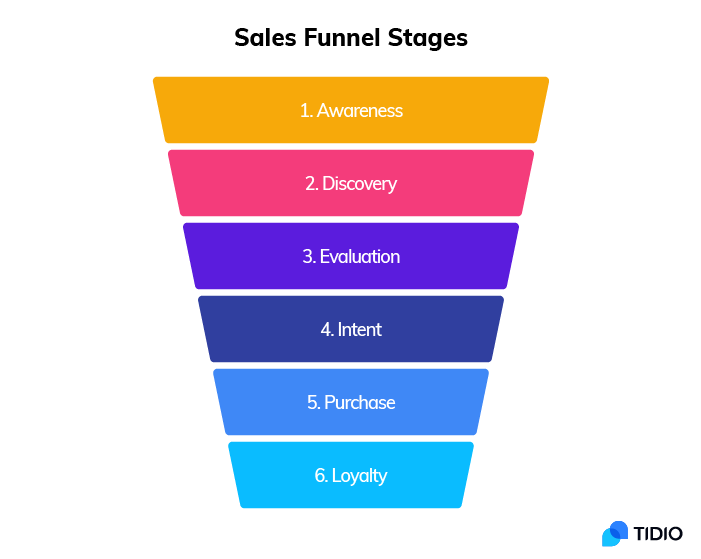
The sales funnel showcases a physical customer journey that they go through every time they decide to make a purchase with a store – from just learning about a brand to becoming its client.
At different stages, they require different sets of approaches:
- If they’re in the “awareness” and “discovery” phase, you need to attract their attention and make aware of your company’s existence.
- If they’re in the “evaluation” and “intent” phase, make an offer based on their searches and incentivize to buy.
- If they’re in the “purchase” and “loyalty” phase, close the deal and keep sending custom-made recommendations.
The hardest part is behind us. Let’s now focus on the tools that can help you segment customers based on the sales funnel and choose appropriate means to follow up those segments.
How to use Google Analytics for customer segmentation?
The easiest way to measure the buying stage of your customers is by picking at their page view history with Google Analytics.
Google Analytics is one of the best online analysis software that has been adopted by millions of store owners to gather in-depth information about the users of their websites. The great thing about the platform is that it comes in a free version and integrates with many other Google products.
Keeping track of page views with Google Analytics gives you the advantage of knowing the types of pages your customers navigated through and how long they stayed there.
With this information, you can create a custom-based segmentation system to measure the popularity of particular subsites (homepage, product page, FAQ page, checkout page) and then target those visitors with dedicated Facebook ads.
With Tidio, you can add custom properties and tags based on visited URLs and target customers with personalized messages. To learn more about Tidio’s contact properties feature, click here.
How to use Facebook Ads for customer retargeting?
Let’s say that someone landed on your homepage for the first time. It would be a pity not to take an interest in a lead if they already have some idea of who you are and what you sell.
By creating a Facebook ad campaign, you’re given the chance to reengage with those people by knowing exactly what they need.
Look at the graphic to see how it works in practice.
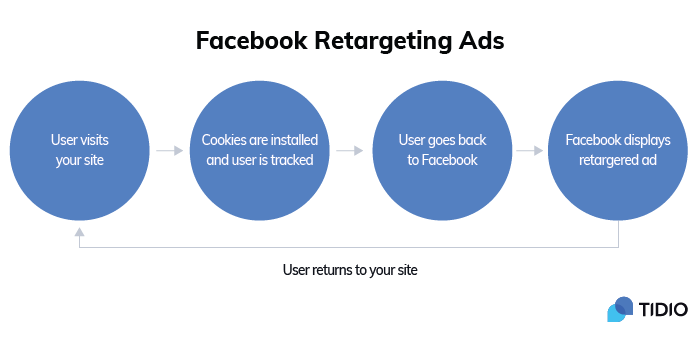
This is what Facebook calls Custom Audiences – targeting particular customer groups with personalized offers in order to increase website traffic and optimize Shopify conversion rates.
But, how do you know what type of ads you should suggest to the customers? You need to run some test campaigns and measure the outcome.
For instance, if someone visited your homepage, you could start from displaying your company’s logo on the customer’s feed. If they visited a dedicated product page, keep showing them the product until they feel the need to buy it! If someone churned during the checkout stage, it’s a must to incentivize them with a discount.
7. Start an Affiliate Program with an Influencer
Affiliate marketing has become a popular tactic to drive sales as more people demonstrate an increasing interest in online shopping.
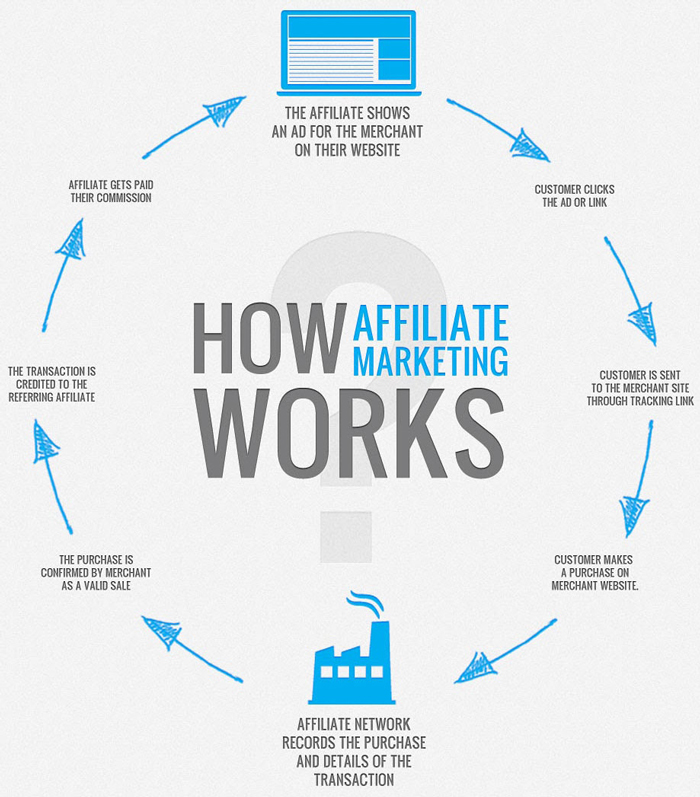
Take a look at the graphic to see how it works in practice.
Affiliate marketing is about creating networks of brand advocates working to promote, recommend and vouch for the company’s goods in exchange for money. By employing influential people, you’re able to reach untapped audiences and sell more products on Shopify.
How to find the perfect affiliate?
BuzzSumo is a popular research tool allowing to find the right influencers who developed their careers around a specific area of interest and will be willing to become the face of your brand.
To start using BuzzSumo (the basic plan starts at $99/mo), simply type in a query you’re most interested in.
Let’s say you sell wooden toys. If you type in the same phrase into the search engine, you’ll see the most commonly shared content on social media about the subject matter (articles, interviews, videos, infographics, etc.).
Then from the multiple results, you can “spy” on people who shared the content and based on their domain authority, number of followers and retweets, and reply ratio, you can choose the one you’re most interested in.
As you grow bigger, you can consider setting up a website for people willing to work with you. At Tidio, we’ve designed the whole homepage for our future affiliates which we divided into four main sections:
- answers to the most frequently asked questions about the program,
- benefits of the partnership,
- customers’ testimonials about our product,
- a sign-in form.
Interested in testing our affiliate workflow? Join our program, become our partner, and see what an affiliate partnership should look like.
Deciding on an affiliate partner, however, is just one side of the coin. Consider the following practices before you agree on the collaboration:
- Offer a tempting commission rate (based on the industry average and your financial capabilities)
- Make sure your affiliate program has clear terms and policies
- Offer relevant product materials so that affiliates have something to work with
- Nurture your relationship with freebies
- Be at their disposal when needed
Pro Tip: The more popular the influencer, the harder it will be to attract their attention. To win them over, it’s imperative to write a compelling email copy like this one. Download the ready-to-use template and start working on your affiliate partnership right away.
8. Shoppable Posts on Instagram
For some time now, Instagram has launched shoppable posts allowing for the entire buying process (from discovery to the checkout) to take place in the app.
Why is this feature relevant?
Because until a few years ago, redirecting clients from Instagram to the store’s website was only possible if its URL was included in the bio section or in Instagram stories (provided you were followed by 10K+ people).
Now, thanks to an Instagram and Shopify integration, Shopify store owners can provide their products with greater publicity by posting them on a well-known platform that is operated by 500 million users every day.
Just like Spearmint Love did.
After introducing shoppable posts in their Instagram feed, Spearmint Love, a children’s clothing company, increased their website traffic by 25% and revenue by 8%.
They managed to achieve these impressively high results because customers value the speed and comfort of making sales in one app.
Because all shoppable Instagram posts are tagged with the brand’s name and price, the only steps a customer has to undertake to finalize the deal include tapping the post to see the product details. From then, they’ll be redirected to your Shopify store, where they can complete the order.
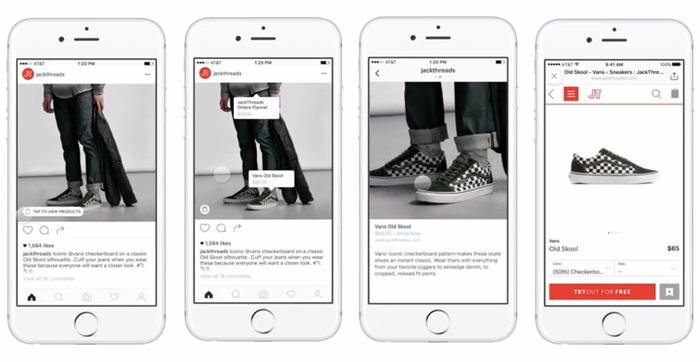
To integrate Instagram with your Shopify store, make sure you fulfill all of the below-listed conditions:
- you subscribe to the Shopify’s Basic plan,
- you own a Facebook business page,
- you have an Instagram business account based in one of these countries,
- your Instagram account is linked to the Facebook page.
How can I implement shoppable posts on Instagram?
Instagram is all about high-quality graphics. This is the reason why certain types of photos receive a higher number of impressions than the other ones.
Remember that it’s not about the product itself but the presentation.
Curalate, visual analytics and marketing platform, took upon itself to analyze the performance of over 800 000 images across Instagram to try to define what makes photos clickable.
Here are some of the tips you should remember to include when composing the perfect picture that will help you sell on Shopify more:
- Images with higher lightness generate 24% more likes
- Images with a high amount of background space generate 29% more likes
- Images with a single predominant color generate 17% more likes
- Images with high levels of texture generate 79% more likes
- Images with low saturation generate 18% more likes
Decide on two or three tips and tempt your customers with high-quality photography.
Final Thoughts
How to verify that a strategy is working?
All of the aforementioned strategies work as blueprints for the company’s main goals. This is why they need to be verified whether they helped to achieve your goal or not. And if they did, to what degree.
Some of the metrics you need to consider during the evaluation of the strategies include:
- Return on Investment (ROI) allows you to check whether the money you’ve invested in a certain marketing strategy brought you actual profit. For instance, if you sent a retargeting Facebook campaign, measure the amount of money you spent on a campaign against the income it brought you.
- Talk with customers to check how their brand awareness has changed as a result of executing particular strategies. Send a quick customer satisfaction survey and ask for their honest thoughts about the product. Learn how to measure customer satisfaction and allow your customers to suggest changes if needed.
- Review the last and this year’s sales numbers to see whether a particular brought losses or profit
- Spy on the competition to see how well their strategies performed compared to yours
There is always room for improvement, so don’t be afraid to introduce changes after having carried out the evaluation. After all, it’s the only way to run a well-prospering Shopify store.
Boost your Shopify website with a live chat to connect with your visitors faster
